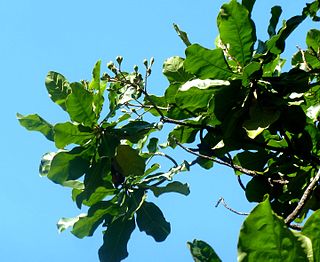
The genus Macrocarpaea, with 105 species and two hybrids of 0.5 m herbs, shrubs, epiphytes and small trees to 10 m tall, is the largest genus of the tribe Helieae of the gentian family (Gentianaceae). Species of Macrocarpaea have diurnal and nocturnal pollinators, visited during the day by hummingbirds, insects and butterflies, and at night by bats, moths and many different kinds of insects. The common name for the genus is 'Moon-gentian'. No species are known in cultivation.

Dillenia is a genus of flowering evergreen or semi-evergreen trees and shrubs in the family Dilleniaceae, native to tropical and subtropical regions of southern Asia, Australasia, and the Indian Ocean islands.

Rhabdodendron is a genus of flowering plant in the family Rhabdodendraceae. It comprises three species of tropical South American trees.

Afrostyrax is a genus of plant in family Huaceae. It contains the following species:
Gentianella hypericoides is a species of flowering plant in the family Gentianaceae. It is endemic to Ecuador. Its natural habitat is subtropical or tropical high-altitude shrubland.

Homalium henriquesii is a species of flowering plant in the family Salicaceae.

Jollydora pierrei is a species of flowering plant in the family Connaraceae. It is endemic to Gabon.
Marcgraviastrum gigantophyllum is a species of flowering plant in the family Marcgraviaceae. It is endemic to Ecuador. The vine's natural habitat is subtropical or tropical moist montane areas of the Andes Ecuadorian ranges.
Memecylon candidum is a species of plant in the family Melastomataceae. It is found in Cameroon and Nigeria. It is threatened by habitat loss.

Memecylon dasyanthum is a species of plant in the family Melastomataceae. It is endemic to Cameroon. Its natural habitat is subtropical or tropical moist montane forests. It is threatened by habitat loss.
Nasa peltata is a species of plant in the Loasaceae family. It is endemic to Ecuador. Its natural habitats are subtropical or tropical moist montane forests and subtropical or tropical dry shrubland.

Anthocleista grandiflora is a species of flowering plant of the family Gentianaceae. It is commonly known as the forest fever tree. It is a tall, slender tree up to 30 m with a preference for forests in high rainfall areas. The leaves are very large, up to 100 cm x 50 cm, arranged in terminal clusters.
Lagenaria rufa is a flowering plant in the family Cucurbitaceae. It is a climbing vine. Its flowers range from white to yellow. The fruit is a gourd, dark green when developing but becomes cream-orange when ripe. It is native to Western Africa.

Hans Schinz was a Swiss explorer and botanist who was a native of Zürich.

Tetracera is a genus of flowering plants of the Dilleniaceae family native to the tropics. Several species are lianas.

Nymphaea nouchali, often known by its synonym Nymphaea stellata, or by common names blue lotus, star lotus, red water lily, dwarf aquarium lily, blue water lily, blue star water lily or manel flower, is a water lily of genus Nymphaea. It is native to southern and eastern parts of Asia, and is the national flower of Bangladesh and Sri Lanka. In Sanskrit it is called utpala. This species is usually considered to include the blue Egyptian lotus N. nouchali var. caerulea. In the past, taxonomic confusion has occurred, with the name Nymphaea nouchali incorrectly applied to Nymphaea pubescens.

Caloncoba is a genus of flowering plants belonging to the family Achariaceae.

Camptostylus is a genus of flowering plants belonging to the family Achariaceae.

Marcgravia pittieri is a species of flowering plant in the family Marcgraviaceae. It is visited by Thomas's nectar bat.














